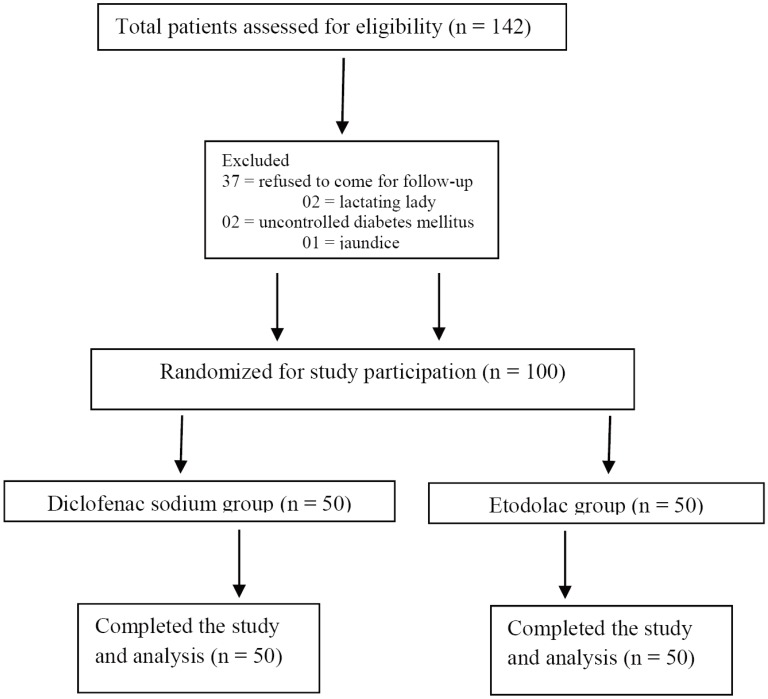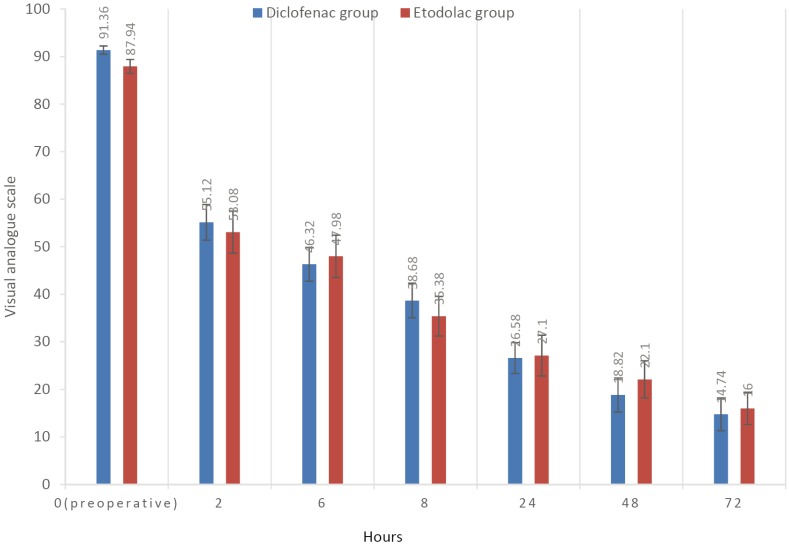1. Nazar MN, Puthiriraj V. Analgesics following mandibular third molar surgery. Int J Pharm Clin Res. 2014; 6:13–19.
2. Deliverska EG, Petkova M. Complications After Extraction of Impacted Third Molars-Literature Review. J IMAB. 2016; 22:1202–1211.
3. Roberts G, Scully C, Shotts R. ABC of oral health: Dental emergencies. BMJ. 2000; 321:559–562. PMID:
10968824.

4. Becker DE, Phero JC. Drug therapy in dental practice: nonopioid and opioid analgesics. Anesth Prog. 2005; 52:140–149. PMID:
16596914.

5. Armstrong AW, Golan DE, Tashjian AH, Armstrong E. Principles of pharmacology: the pathophysiologic basis of drug therapy. 2nd ed. Philadelphia: Wolters Kluwer Health/Lippincott Williams & Wilkins;2008.
6. Tripathi KD. Essentials of Medical Pharmacology. New Delhi: India Jaypee Bros;2013.
7. Kaplan V, Eroğlu CN. Comparison of the effects of daily single-dose use of flurbiprofen, diclofenac sodium, and tenoxicam on postoperative pain, swelling, and trismus: a randomized double-blind study. J Oral Maxillofac Surg. 2016; 74:1946.e1–1946.e6. PMID:
27311846.

8. Prashar DV, Pahwa D, Kalia V, Jindal G, Kaur R. A comparative evaluation of the effect of diclofenac sodium with and without per-orally administered methylprednisolone on the sequelae of impacted mandibular third molar removal: A cohort randomized double-blind clinical trial. Indian J Dent. 2016; 7:11–16. PMID:
27134449.

9. Nícoli GA, Conte-neto N, Bonini-campos JÁ, Cabrini-Gabrielli MA, Pereira-Filho VA. Efficacy of lumiracoxib versus diclofenac sodium in pain control following extraction of impacted lower third molar. Int J Odontostomat. 2017; 11:47–51.

10. Zuniga JR, Phillips CL, Shugars D, Lyon JA, Peroutka SJ, Swarbrick J, et al. Analgesic safety and efficacy of diclofenac sodium softgels on postoperative third molar extraction pain. J Oral Maxillofac Surg. 2004; 62:806–815. PMID:
15218558.

11. Mohammad S, Singh V, Wadhwani P, Tayade HP, Rathod OK. Sublingual piroxicam in the management of postoperative pain after surgical removal of impacted mandibular third molar. Indian J Dent Res. 2012; 23:839–840. PMID:
23649080.

12. Orozco-Solís M, García-Ávalos Y, Pichardo-Ramírez C, Tobías-Azúa F, Zapata-Morales JR, Aragon-Martínez OH, et al. Single dose of diclofenac or meloxicam for control of pain, facial swelling, and trismus in oral surgery. Med Oral Patol Oral Cir Bucal. 2016; 21:e127–e134. PMID:
26615509.
13. Buyukkurt MC, Gungormus M, Kaya O. The effect of a single dose prednisolone with and without diclofenac on pain, trismus, and swelling after removal of mandibular third molars. J Oral Maxillofac Surg. 2006; 64:1761–1766. PMID:
17113442.

14. Bachalli PS, Nandakumar H, Srinath N. A comparitive study of diclofenac transdermal patch against oral diclofenac for pain control following removal of mandibular impacted third molars. J Maxillofac Oral Surg. 2009; 8:167–172. PMID:
23139499.

15. Chunduri NS, Kollu T, Goteki VR, Mallela KK, Madasu K. Efficacy of aceclofenac and diclofenac sodium for relief of postoperative pain after third molar surgery: A randomised open label comparative study. J Pharmacol Pharmacother. 2013; 4:144–145. PMID:
23761713.

16. Gan TJ. Diclofenac: an update on its mechanism of action and safety profile. Curr Med Res Opin. 2010; 26:1715–1731. PMID:
20470236.

17. Köseoğlu BG, Öztürk Ş, Koçak H, Palanduz Ş, Çefle K. The effects of etodolac, nimesulid and naproxen sodium on the frequency of sister chromatid exchange after enclused third molars surgery. Yonsei Med J. 2008; 49:742–747. PMID:
18972594.

18. Comfort MB, Tse AS, Tsang AC, McGrath C. A study of the comparative efficacy of three common analgesics in the control of pain after third. Aust Dent J. 2002; 47:327–330. PMID:
12587769.
19. Silva de Oliveira JC, Grossi de Oliveira GA, Bassi AP. Comparative assessment of the effect of ibuprofen and etodolac on edema, trismus, and pain in lower third molar surgery: a randomized clinical trial. J Oral Maxillofac Surg. 2016; 74:1524–1530. PMID:
27160363.

20. Sethi P, Agarwal M, Chourasia HR, Singh MP. Effect of single dose pretreatment analgesia with three different analgesics on postoperative endodontic pain: A randomized clinical trial. J Conserv Dent. 2014; 17:517–521. PMID:
25506136.

21. Hutton CE. The effectiveness of 100 and 200 mg etodolac (Ultradol), aspirin, and placebo in patients with pain following oral surgery. Oral Surg Oral Med Oral Pathol. 1983; 56:575–580. PMID:
6228772.

22. Trindade PA, Giglio FP, Colombini-Ishikiriama BL, Calvo AM, Modena KC, Ribeiro DA, et al. Sublingual ketorolac and sublingual piroxicam are equally effective for postoperative pain, trismus, and swelling management in lower third molar removal. Oral Surg Oral Med Oral Pathol Oral Radiol. 2012; 114:27–34. PMID:
22732846.

23. Bellamy N. Etodolac in the management of pain: A clinical review of a multipurpose analgesic. Inflammopharmacology. 1997; 5:139–152. PMID:
17694363.

24. Lustenberger FD, Grätz KW, Mutzbauer TS. Efficacy of ibuprofen versus lornoxicam after third molar surgery: A randomized, double-blind, crossover pilot study. Oral Maxillofac Surg. 2011; 15:57–62. PMID:
21120558.

25. Rayati F, Hajmanouchehri F, Najafi E. Comparison of anti-inflammatory and analgesic effects of Ginger powder and Ibuprofen in postsurgical pain model: A randomized, double-blind, case-control clinical trial. Dent Res J (Isfahan). 2017; 14:1–7. PMID:
28348610.

26. Akbulut N, Üstüner E, Atakan C, Çölok G. Comparison of the effect of naproxen, etodolac and diclofenac on postoperative sequels following third molar surgery: a randomised, double-blind, crossover study. Med Oral Patol Oral Cir Bucal. 2014; 19:e149–e156. PMID:
24316711.
27. Garg Y, Singh J, Sohal HS, Gore R, Kumar A. Comparison of clinical effectiveness and safety of newer nonsteroidal anti-inflammatory drugs in patients of osteoarthritis of knee joint: A randomized, prospective, open-label parallel-group study. Indian J Pharmacol. 2017; 49:383–389. PMID:
29515279.
28. Tirunagari SK, Derry S, Moore RA, McQuay HJ. Single dose oral etodolac for acute postoperative pain in adults. Cochrane Database Syst Rev. 2009; CD007357. PMID:
19588426.

29. Bodian CA, Freedman G, Hossain S, Eisenkraft JB, Beilin Y. The visual analog scale for pain: clinical significance in postoperative patients. Anesthesiology. 2001; 95:1356–1361. PMID:
11748392.
30. Collins SL, Moore RA, McQuay HJ. The visual analogue pain intensity scale: what is moderate pain in millimetres? Pain. 1997; 72:95–97. PMID:
9272792.

31. Rakhshan V. Common risk factors for postoperative pain following the extraction of wisdom teeth. J Korean Assoc Oral Maxillofac Surg. 2015; 41:59–65. PMID:
25922816.

32. Paudel R, Deka A, Gupta HK, Nepal HP. Comparative evaluation of analgesic efficacy of tramadol and diclofenac-sodium in post-operative orthopedic patients. Int J Basic Clin Pharmacol. 2017; 6:2676–2683.

33. Christensen K, Daniels S, Bandy D, Ernst CC, Hamilton DA, Mermelstein FH, et al. A double-blind placebo controlled comparison of a novel formulation of intravenous diclofenac and ketorolac for postoperative third molar extraction pain. Anesth Prog. 2011; 58:73–81. PMID:
21679043.
34. Lonauer G, Tisscher JR, Lim HG, Bijlsma JW. Double-blind comparison of etodolac and diclofenac in patients with rheumatoid arthritis. Curr Med Res Opin. 1993; 13:70–77. PMID:
8325044.
35. Pareek A, Chandurkar N, Gupta A, Desai Y, Kumar SH, Swamy A, et al. Comparative evaluation of efficacy and safety of etodolac and diclofenac sodium injection in patients with postoperative orthopedic pain. Curr Med Res Opin. 2011; 27:2107–2115. PMID:
21942465.

36. Gaston GW, Mallow RD, Frank JE. The efficacy of etodolac for patients with pain following oral surgery. J Oral Maxillofac Surg. 1984; 42:362–366. PMID:
6232359.

37. Inoue K, Fujisawa H, Motonaga A, Inoue Y, Kyoi T, Ueda F, et al. Anti-inflammatory effects of etodolac: comparison with other non-steroidal anti-inflammatory drugs. Biol Pharm Bull. 1994; 17:1577–1583. PMID:
7735198.

38. Weideman RA, Kelly KC, Kazi S, Cung A, Roberts KW, Smith HJ, et al. Risks of clinically significant upper gastrointestinal events with etodolac and naproxen: a historical cohort analysis. Gastroenterology. 2004; 127:1322–1328. PMID:
15521001.








 PDF
PDF ePub
ePub Citation
Citation Print
Print







 XML Download
XML Download